Are you wondering how to set up a preschool classroom? This post will walk you through everything you need to know about preschool classrooms.

What Do Kids Learn in Preschool?
Preschool is typically focused on developing a strong academic and social foundation for younger children before they enter Kindergarten. Preschool children learn so many important academic concepts, plus develop social skills, emotional regulation, and so much more! Here are just a few of the concepts kids learn in preschool:
- Problem Solving
- Turn Taking
- Early math concepts like counting, numbers, and shapes
- Letters
- Colors
- Fine motor skills
- Gross motor skills
- Language and vocabulary
- Listening and speaking skills
What Makes the Best Pre-K Classroom?
The best Pre-K classroom is one that is safe, inviting, and set up in a way that fosters student learning, engagement, and exploration. There are many ways to create this environment for your preschool students!
Meaningful and Age Appropriate Preschool Classroom Rules
Children should be included in creating classroom rules. This is a great activity for the first week of preschool. If you are looking for more teaching ideas for the first day of preschool, read this post: 5 Preschool First Day Activities to Set Your Year up for Success.

I recommend reading a book such as David Goes to School and then making a list of classroom rules together. Just like everything in preschool this lesson should be short and sweet to keep students’ attention. Here are a few meaningful and age-appropriate preschool classroom rules to get you started:
- Use kind words.
- Listen to others.
- Keep each other safe.
- Take care of our things.
Diverse, Interest-Based Preschool Classroom Toys
It’s also important to have diverse, interest-based toys. Usually, toys are included in various centers and promote dramatic play. Here are a few popular toys to have in your classroom for your preschoolers to enjoy:
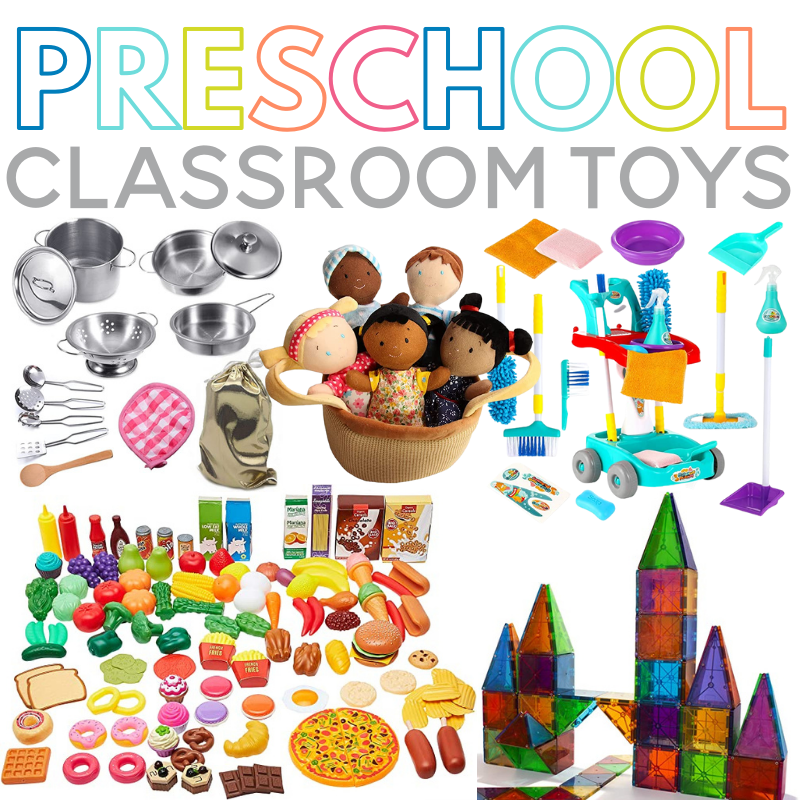
- Dolls
- Dollhouse
- Play Food
- Tools
- Blocks
- Magnetic Tiles
- Pretend Home Items such as play cleaning tools and cooking supplies
- Dress Up Clothes
- Light Table
- Puzzles
Don’t forget to add labels to the bins where materials are stored. This gets students involved in the clean-up process.
Ample Preschool Classroom Supplies
Having an ample amount of preschool classroom supplies is very helpful.
At the beginning of the school year, I always like to put some school supplies away for the second half of the year. September can also be a great time to stock up on classroom supplies because they are often discounted as stories try to clear them out at the end of the back-to-school season.
If you don’t have the classroom supplies that you need, consider creating an Amazon Wish List or even asking parents for donations.
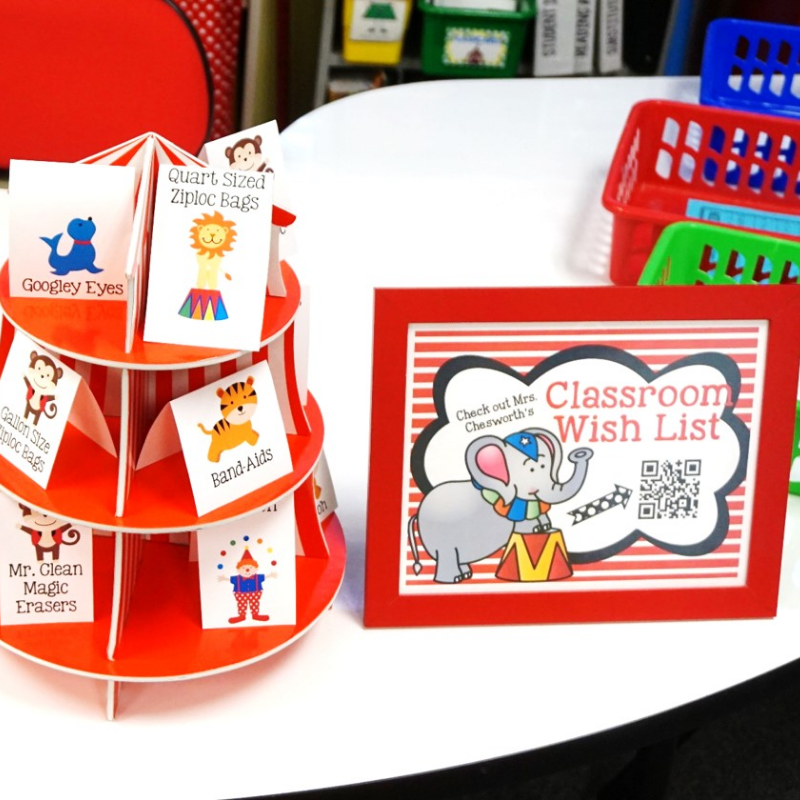
Intentional Preschool Classroom Design
You definitely want to be intentional about the design of your classroom. First, take a look at the furniture in your classroom and what areas can’t be changed. For example, the water fountain probably can’t be moved and it’s probably not in the budget for your principal to order rectangular tables to replace your round tables right now.
Some teachers find it helpful to draw a sketch of their classroom and other teachers just like to experiment with classroom design by moving furniture around.
Here are a few things to think about when designing your classroom:
- Where will I do my whole group teaching?
- Where will I do my small group teaching?
- Where can students work independently?
- Where will students store the things they bring from their homes like backpacks, water bottles, and jackets?
- What center areas are needed? What will the noise level of each area be? A noisy dramatic play area might not be best next to a quieter listen-to-reading station. If you are planning on including a writing center, be sure to check out this post: How to Create a Writing Center Your Students Will Love.
- What things need to be displayed on the classroom walls?
- Is there a quiet space for students who may need some downtime?
- Does my classroom need spaces for students to rest or eat?
- What labels can I add to help with independence?
Preschool Supplies Must Haves
It’s important to figure out how your school handles school supplies. Sometimes teachers will provide a list of school supplies for students to purchase and bring to school. Other times, students will pay a supply fee and the school will take care of supplies. Other times teachers have a budget to purchase the supplies they need for their classroom.
No matter how your school handles preschool supplies, I think the following items are must-haves:
- Markers
- Crayons
- Glue sticks and glue bottles
- Paper (colored and plain)
- Scissors
- Play Dough
- Writing materials
- Center materials (more of this later!)
It’s also important to think about how you want to handle classroom supplies. Will, you have plastic caddies set up at each table for community supplies? Or will students be responsible for their own supplies and store them in a school box or plastic bag?
I think plastic bins or buckets are very helpful for organizing supplies and can be found at many stores!
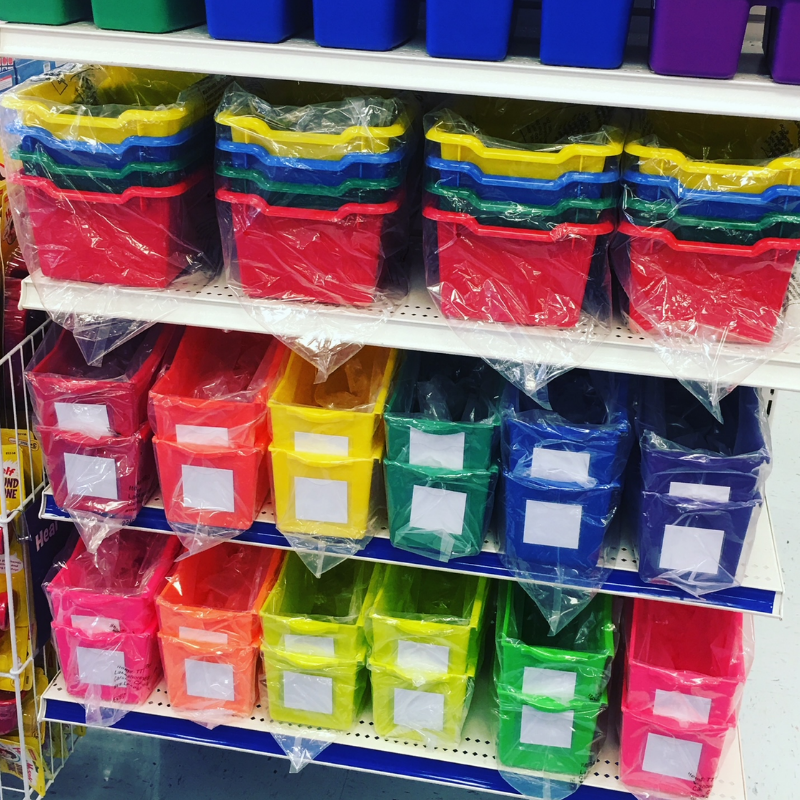
Preschool Classroom Decorating Ideas
Choosing a classroom theme can help with classroom decorating. The options are endless, but I recommend choosing something that has readily available materials and a theme that would appeal to all students. I also find that it can be helpful (and visually appealing) to stick to a few colors.
Keep in mind that some schools will choose a school-wide theme that all teachers use to decorate for that school year.
Themed Door Decoration for Preschool Classroom
Welcome your students into your classroom with a themed door decoration. Students will actually see the classroom door before they see the classroom!
Both the inside and the outside of classroom doors could be decorated. However, if you are short on classroom wall space it might be helpful to use your classroom door for something like a classroom job chart or to hold library cards, etc.
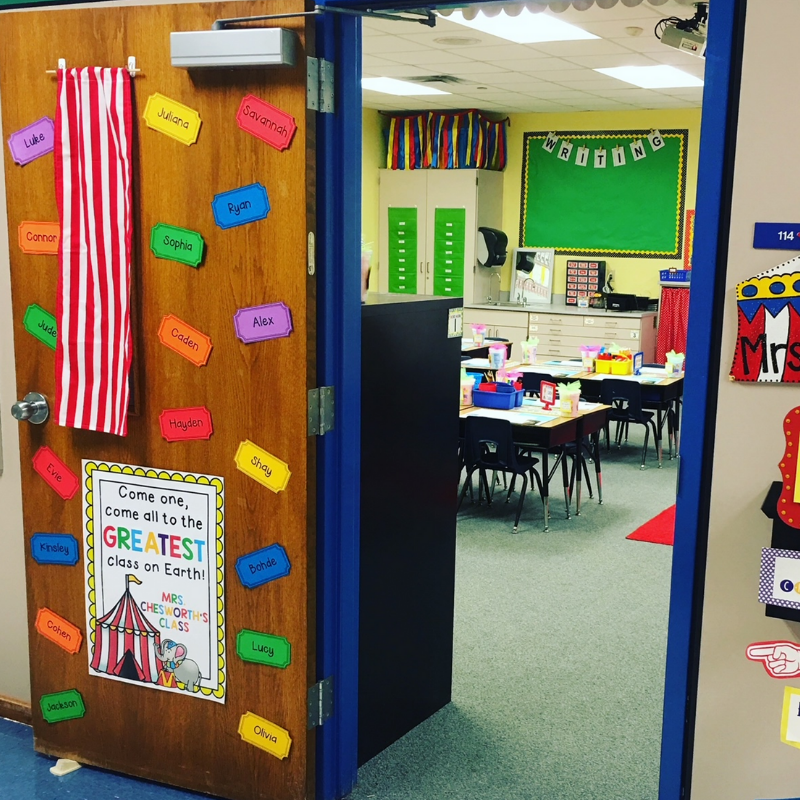
Seasonal and Back to School Preschool Bulletin Boards
If your classroom has a bulletin board in the hallway, this can be a great place to display seasonal student work!
During back-to-school time, when you don’t have any student work to display use this area as a fun photo backdrop to match your classroom theme. Parents will love taking first-day photos in front of it!
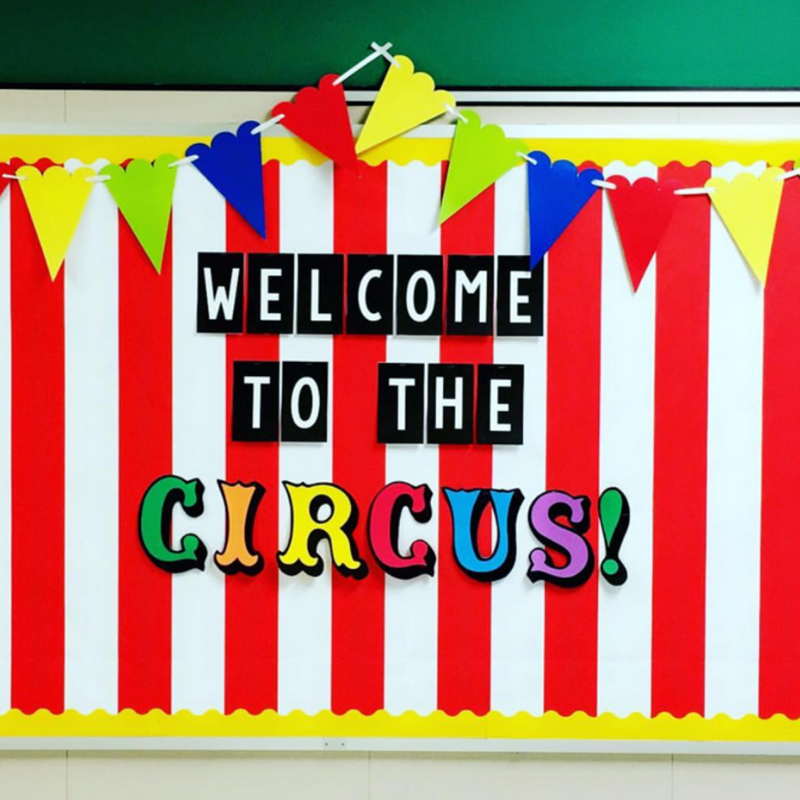
Seasonal and Themed Decorations
Many teachers enjoy changing bulletin boards and door decorations out seasonally. If you enjoy doing this, go for it! If not, it’s totally fine to keep the same items up throughout the year.
I always highly recommend using student work whenever possible!
Decorations and Toys at Child Eye Level
I think it’s always important to look at the room from a child’s eye level. Here are a few questions to ask:
- Can students easily access the materials and information that they need?
- Are there unnecessary decorations or distractions in key teaching areas?
The room should always be centered around students and their needs.
Differentiated and Identifiable Centers
Centers are such an important part of the early childhood experience and foster play based learning. Centers are clearly defined areas with a specific focus and materials for students to use. Each center in your classroom should be intentionally designed.
I find that engagement always increases when kids can choose their own learning centers and play-based learning is always best.
The options for learning centers are endless, but here are a few centers to consider:
- Science center
- Math center with math manipulatives for students to explore math concepts
- Dramatic play area
- Art Center
- Blocks
- Home Center
- Writing Center
- Music
- Reading Center with books for students to read or listen to
- Technology (Computer, iPads, etc.)
- Puppet Theatre
- Fine Motor Practice
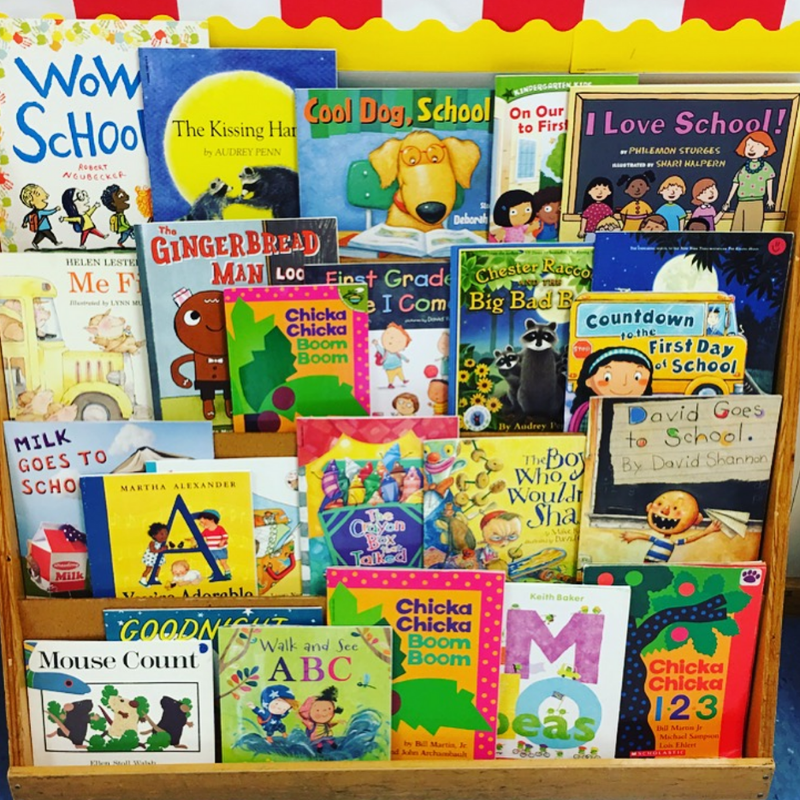
Don’t forget to add a label or sign to each center to define the space. I always think signs with pictures of students or student-created signs are best!
Age Appropriate Seating and Toys
Age-appropriate seating and toys in an early childhood classroom make a huge difference in the flow of the classroom. Tables and rugs are usually the best choices for preschoolers.
Diverse Reading Material
It’s important to fill your class library with diverse reading materials that are representative of the world. The books included in your classroom should show different races, cultures, and abilities. All students should see themselves represented in children’s books.
Reading books can help students see the similarities and differences in people in a positive way. Your school librarian can be a great resource for choosing diverse reading materials!
Circle Time Equipment
One of the most important areas is the space used for circle time or whole group teaching time. Early childhood classrooms typically should have the following circle time equipment:
- An easel with chart paper
- A chair for the teacher to sit and read books, etc.
- A large carpet or rug for all students to comfortably sit
Job Chart
A job chart is a great way to involve students in classroom responsibilities and help them take ownership at school. Typically, a job chart can be displayed somewhere on the classroom wall and students will change jobs each week.
I always recommend having enough classroom jobs so that every student has a job. Some jobs could have two or more students assigned to them too if needed.
Visual Daily Schedule
Having a visual daily schedule is a must in a preschool classroom! It’s helpful for students to learn the routine and know what is coming next. It develops a sense of security when children know what to expect.
Since most preschoolers usually can’t yet read, having a visual schedule with pictures is really important. There are many schedule cards available for purchase. However, I think it’s a great idea to take pictures of your students and create a visual daily schedule together.
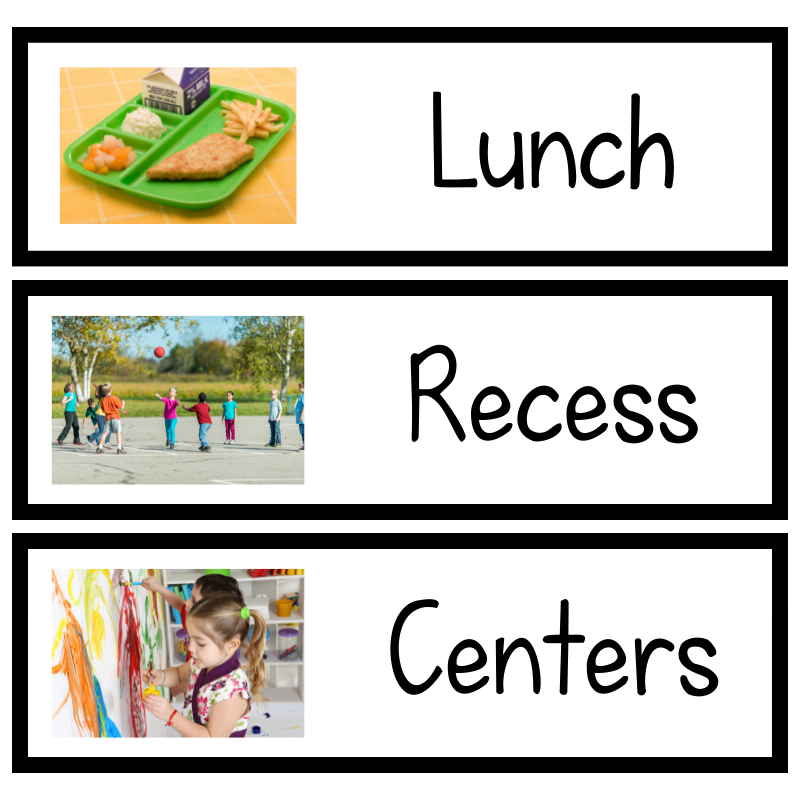
Plants and/or Pets
Does anyone else have vivid memories of classroom pets as a child? I remember watching a classroom pet snake eat a mouse whole! Classroom pets and plants can be a fun addition to the preschool classroom. However, it’s very important to discuss this with your principal and ensure you are following school policies and that you have their support.
A class plant may be more manageable, or consider only having a classroom pet temporarily such as hatching chicks! You can learn more about how to do this by reading this post, How to Hatch Chicks in the Classroom.
H2: Classroom Decorating Themes for Preschool
Choosing a classroom theme can help your classroom feel cohesive and make decorating easier. Check out any teacher store like Lakeshore Learning for theme inspiration or consider choosing a few colors to decorate with instead.
Preschool Classroom Ideas FAQ
Here are a few frequently asked questions about preschool classrooms
Why Is Classroom Management Important?
Effective classroom management creates a safe and healthy learning environment for your students. If your classroom is out of control, teaching (and learning!) can be very difficult. Like all good things, classroom management can take some time to develop and even seasoned teachers have tough years when it comes to classroom management.
When thinking about preschool classroom management, it’s important to remember the age of your students. Preschool-aged children have short attention spans and need clear, quick directions. Plan your lessons with realistic expectations and spend lots of time teaching routines and transitions.
How Often Should You Change Decorations or Themes in a Preschool Class?
You always want to keep your students excited and engaged with learning, so themes should be changed when students begin to lose interest. The most popular options are changing themes monthly, every two weeks, or weekly. You can read more about preschool themes in this post, Preschool Themes for Every Month.
How Big Should a Preschool Classroom Be?
The size of a preschool classroom is set by the state. In Texas, Administrative Code states that prekindergarten classrooms should have a minimum of 800 square feet per room. School districts with small class sizes can have classrooms that provide a minimum of 36 square feet per student.
Most teachers don’t have any control over the size of their classrooms. Teachers are usually just assigned a classroom by their administrator. Schools are built to code, so your child’s preschool classroom is most likely big enough from a square footage standpoint.
How Many Students Should Be in a Preschool Classroom?
Various studies have been done on how many students should be in a preschool classroom, but there is no “magic number.” Instead, rules and guidelines for class size and student-to-teacher ratios are set by state education agencies and other licensing agencies. 22 students to 2 teachers is a common preschool classroom class size in the United States.
I recommend researching your state to see the maximum number of preschool students that could be in a classroom as well as how many teachers would be caring for and teaching students. Class size is a great thing to discuss with your child’s preschool teacher.
Preschool Classroom Designs: The Bottom Line
Preschool classrooms should be a warm and friendly place for students to learn! Preschool teachers should design their preschool classrooms to meet the needs of their students.
